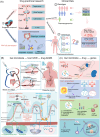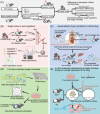A new evaluation system for drug-microbiota interactions
- PMID: 38898986
- PMCID: PMC11183188
- DOI: 10.1002/imt2.199
A new evaluation system for drug-microbiota interactions
Abstract
The drug response phenotype is determined by a combination of genetic and environmental factors. The high clinical conversion failure rate of gene-targeted drugs might be attributed to the lack of emphasis on environmental factors and the inherent individual variability in drug response (IVDR). Current evidence suggests that environmental variables, rather than the disease itself, are the primary determinants of both gut microbiota composition and drug metabolism. Additionally, individual differences in gut microbiota create a unique metabolic environment that influences the in vivo processes underlying drug absorption, distribution, metabolism, and excretion (ADME). Here, we discuss how gut microbiota, shaped by both genetic and environmental factors, affects the host's ADME microenvironment within a new evaluation system for drug-microbiota interactions. Furthermore, we propose a new top-down research approach to investigate the intricate nature of drug-microbiota interactions in vivo. This approach utilizes germ-free animal models, providing foundation for the development of a new evaluation system for drug-microbiota interactions.
Keywords: drug metabolism; drug–microbiota interactions; genetic and environmental factors; gut microbiota.
© 2024 The Authors. iMeta published by John Wiley & Sons Australia, Ltd on behalf of iMeta Science.
Conflict of interest statement
The authors declare no conflict of interest.
Figures



Similar articles
-
Drug-microbiota interactions: an emerging priority for precision medicine.Signal Transduct Target Ther. 2023 Oct 9;8(1):386. doi: 10.1038/s41392-023-01619-w. Signal Transduct Target Ther. 2023. PMID: 37806986 Free PMC article. Review.
-
Colonization-induced host-gut microbial metabolic interaction.mBio. 2011 Mar 1;2(2):e00271-10. doi: 10.1128/mBio.00271-10. Print 2011. mBio. 2011. PMID: 21363910 Free PMC article.
-
Microbiota and Colorectal Cancer: From Gut to Bedside.Front Pharmacol. 2021 Sep 30;12:760280. doi: 10.3389/fphar.2021.760280. eCollection 2021. Front Pharmacol. 2021. PMID: 34658896 Free PMC article. Review.
-
Diversity and host interaction of the gut microbiota in specific pathogen-free pigs.Front Microbiol. 2024 May 10;15:1402807. doi: 10.3389/fmicb.2024.1402807. eCollection 2024. Front Microbiol. 2024. PMID: 38800748 Free PMC article.
-
Effects of intestinal flora on pharmacokinetics and pharmacodynamics of drugs.Drug Metab Rev. 2023 Feb-May;55(1-2):126-139. doi: 10.1080/03602532.2023.2186313. Epub 2023 Mar 14. Drug Metab Rev. 2023. PMID: 36916327 Review.
Cited by
-
Gut Microbiota Modulation by Lysozyme as a Key Regulator of Vascular Inflammatory Aging.Research (Wash D C). 2025 May 23;8:0704. doi: 10.34133/research.0704. eCollection 2025. Research (Wash D C). 2025. PMID: 40416362 Free PMC article.
-
Spinal cord injury: pathophysiology, possible treatments and the role of the gut microbiota.Front Microbiol. 2024 Dec 18;15:1490855. doi: 10.3389/fmicb.2024.1490855. eCollection 2024. Front Microbiol. 2024. PMID: 39744391 Free PMC article. Review.
References
LinkOut - more resources
Full Text Sources
